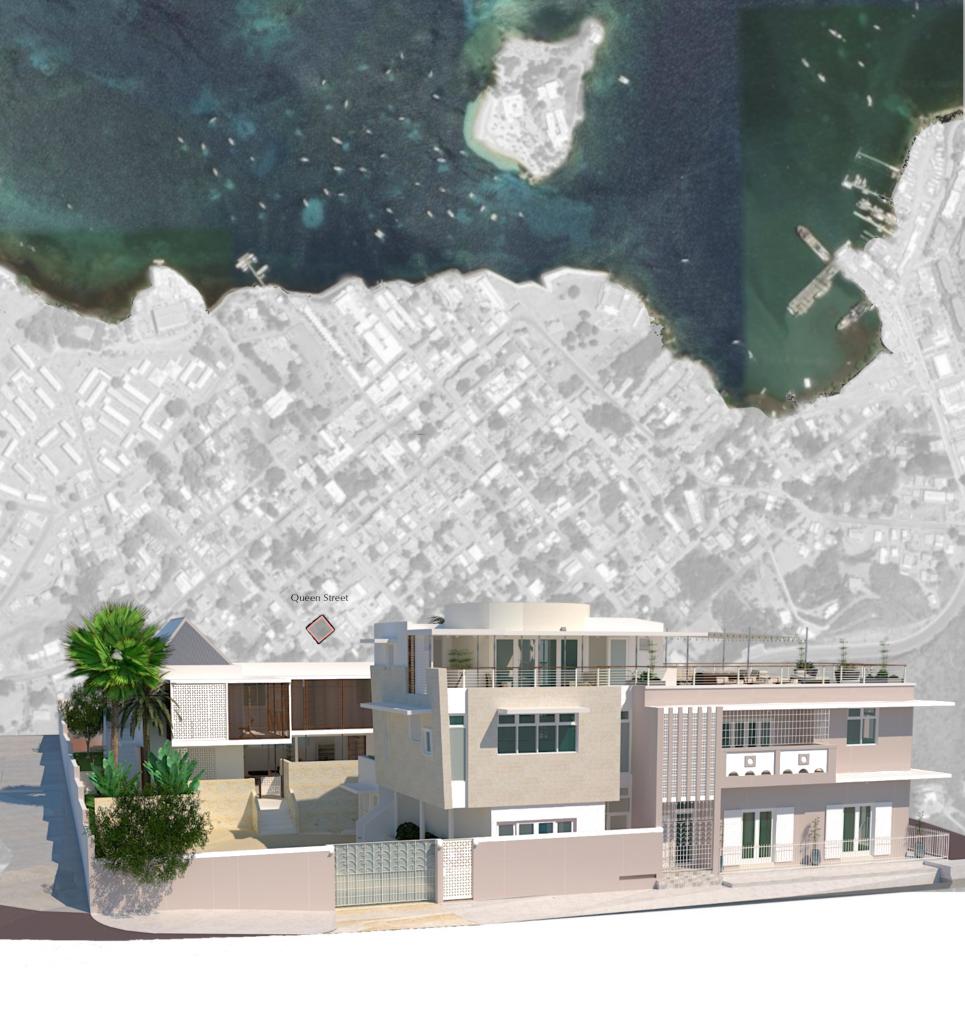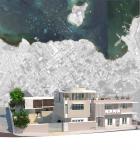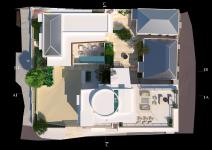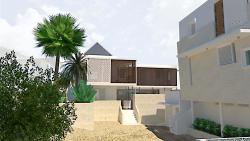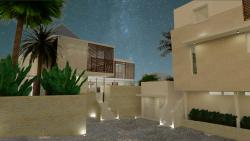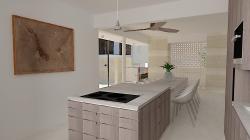Bohio Rojas, located in the architectural historic control district of Christiansted, is built on a site comprised of three plots subdivided over time from its original lot on Queen Street. The planned town of Christiansted dates back to its founding in 1733. Presently, the site accommodates two historic wooden vernacular cottages dating from the 1850s, as well as a masonry 2-story Mid-century modern townhouse built in 1954 anchors the intersection of Queen & Market Streets. The 1779 Oxholm map indicates a large townhouse once existed on the site that spanned the original square lot. The owner is developing the site's 3 lots into a singular cohesive compound.
This residential and commercial project was a case study within the Christiansted Town Plan competition, won in 2013 and enacted in 2016. The plan's primary catalyst was to increase the number of habitable residences in the town by restoring shuttered and dilapidated residential properties.
The compound is defined by a new perimeter fence and entry gate along Queen Street. The resulting defined outdoor spaces enhance the infill and historic structures by promoting indoor/outdoor living while buffering them from the bustling intersection. The addition to the townhouse structure references the building footprint from the 1779 map while preserving its hierarchy at the corner. Metal and glass are used to create a clear separation between the old and new structures. New steel colonnades reference the unique loggias ubiquitous in both designed historic towns on St. Croix: Christiansted and Frederiksted. Slatted wood screens and opaque translucent panels afford layers of privacy from the street while allowing light and airflow in varying spaces. Using a traditional Christiansted color scheme, the delineation between new and old is marked by using a pale rose limewash pigment for historic structures and distinguishing contemporary ones with ivory, white, and pale-cream pigments.
As the largest building on the property, the Mid-century modern structure, with its clean geometric lines and banding, provides the design cues for the contemporary infill structures. Neighboring town structures built around the same period exhibit similar detailing reinterpreted in the new design. The design intent is to harmonize varying building periods with fenestrations that are still sympathetic to the overall Danish West Indian colonial architecture, built by ancestral Enslaved Africans and found throughout the town.
The existing townhouse has a professional office and art gallery on the ground floor and a private residence located on the second floor. The vacant vernacular cottages are being restored to become short-term rental units. These units, in conjunction with a new L-shaped contemporary structure with a 2nd-floor apartment and ground-floor lounge, will create a new bed & breakfast business for the property owners. Off-street parking for five vehicles, a swimming pool with a deck adjacent to a dining room, a chef's kitchen, and a lounge area are the program elements for this compound. This space will also accommodate rentals for small corporate events, allowing guests/visitors to mingle with locals. The newly accessible rooftop will also be open for use by the owners and guests, providing panoramic town and sea views.
Sustainable components in the design are numerous, including recycling existing and installing new cisterns, constructing with bio-blocks, using percolating ground cover systems, slatted units to promote natural ventilation, skylights for increased interior natural light, stamped powder-coated steel perforated with an Akan Krapa icon (a symbol of protection), and solar power systems installed on flat roofs.
2023
Airmaster PR window & door units, galvanized corrugated metal panel units, limewash paint, recycled wrought iron metalwork, cistern catchment (recoated & new construction).
Gerville R. Larsen, A.I.A.
